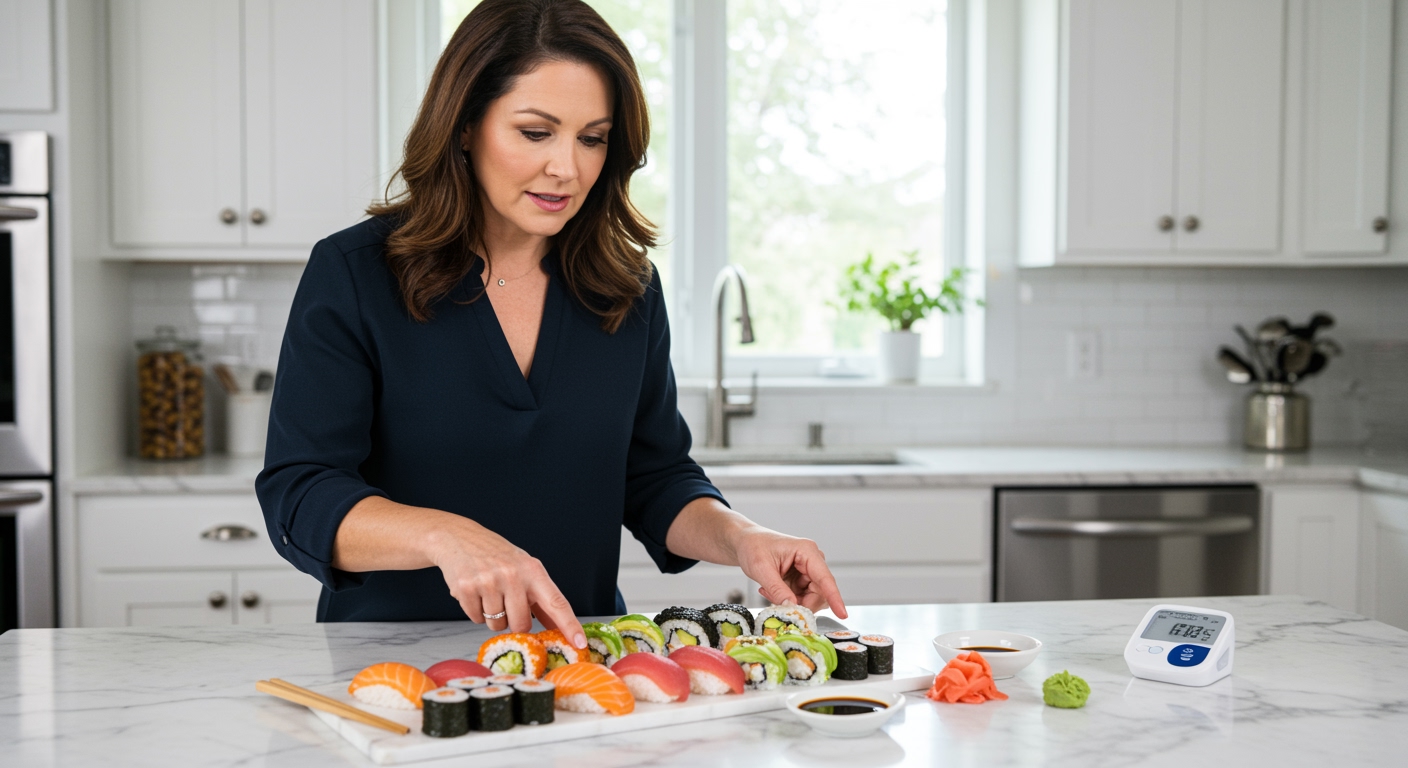✪ Key Takeaway: Sushi can be good for high blood pressure when you choose low-sodium options and avoid high-salt sauces and processed ingredients.
Introduction
You walk into your favorite sushi restaurant and wonder if those beautiful rolls will spike your blood pressure.
Many people with high blood pressure ask this question because they love sushi but worry about the sodium content hiding in soy sauce, pickled vegetables, and processed ingredients.
Hi, I’m Abdur, your nutrition coach and today I’m going to explain exactly how sushi affects your blood pressure and which types you can enjoy safely.
What Makes Sushi Heart-Healthy or Harmful?
The foundation of most sushi is actually excellent for blood pressure management.
Fresh fish provides omega-3 fatty acids that help reduce inflammation in your blood vessels and support healthy circulation.
These healthy fats work by making your blood vessel walls more flexible and reducing the stiffness that contributes to high blood pressure.
Rice, the other main component, contains minimal sodium when prepared without added salt.
Vegetables like cucumber, avocado, and seaweed add potassium and magnesium, two minerals that help your kidneys regulate blood pressure naturally.
The problem starts when restaurants add high-sodium ingredients like tempura batter, spicy mayo, and processed fish products that can contain over 500mg of sodium per serving.
✪ Fact: One tablespoon of regular soy sauce contains about 1000mg of sodium, nearly half your daily limit.
Which Sushi Types Should You Choose?
Simple nigiri and sashimi are your best choices because they contain only fresh fish and minimal rice.
These options give you maximum omega-3 benefits without hidden sodium from sauces or fried ingredients.
Salmon, tuna, and mackerel are particularly beneficial because they contain the highest levels of heart-protective omega-3s.
Vegetable rolls with cucumber, avocado, or asparagus provide fiber and potassium while keeping sodium levels low.
California rolls can work if made with real crab instead of processed imitation crab, which often contains high amounts of sodium for preservation.
Avoid anything tempura or fried, as these preparations add unnecessary sodium and unhealthy fats that can worsen blood pressure.
✪ Pro Tip: Ask your sushi chef to prepare rolls without added salt in the rice for even lower sodium content.
How Do Sauces and Condiments Affect Blood Pressure?
Regular soy sauce is the biggest culprit when it comes to sodium in sushi meals.
Just two tablespoons can push you over your daily sodium limit, causing your body to retain water and increase blood pressure within hours.
Low-sodium soy sauce contains about 40% less sodium but still requires moderation to stay within healthy limits.
Spicy mayo, eel sauce, and other specialty sauces often contain even more sodium than regular soy sauce, plus added sugars that can contribute to inflammation.
Wasabi, when made from real wasabi root, contains compounds that may actually help improve circulation and support healthy blood pressure.
Pickled ginger provides digestive benefits but contains moderate sodium, so limit yourself to a few pieces per meal.
✪ Note: Most restaurant wasabi is actually horseradish with green coloring and contains added sodium.
What About Portion Sizes and Frequency?
Even heart-healthy sushi can become problematic if you eat too much at once or too frequently.
A reasonable portion for someone with high blood pressure is 6-8 pieces of sushi or 2-3 rolls, depending on their size and ingredients.
This amount provides beneficial omega-3s without overwhelming your system with sodium or calories.
Eating sushi 1-2 times per week fits well into a heart-healthy diet, especially when balanced with other low-sodium meals.
Pay attention to your body’s response after eating sushi – some people notice bloating or increased thirst, which indicates too much sodium.
If you experience these symptoms, reduce portion sizes or choose simpler preparations with less sauce next time.
✪ Pro Tip: Drink extra water after eating sushi to help your kidneys process any excess sodium more efficiently.
The Bottom Line
Sushi can definitely be part of a blood pressure-friendly diet when you make smart choices about types, portions, and condiments.
The key to healthy eating is not avoiding foods you love, but learning how to enjoy them in ways that support your health goals.
I would love to hear about your favorite low-sodium sushi combinations or any questions you have about making restaurant meals work with your blood pressure management plan in the comments below.
References
At NutritionCrown, we use quality and credible sources to ensure our content is accurate and trustworthy. Below are the sources referenced in creating this article:
- Science Daily: Fish consumption linked to lower blood pressure
- The Kidney Dietitian: Low Sodium Sushi: The Ultimate Guide
- Sushi Hana: Can I Eat Sushi on a Low Sodium Diet
- Nature: Omega-3 fatty acids and blood pressure





